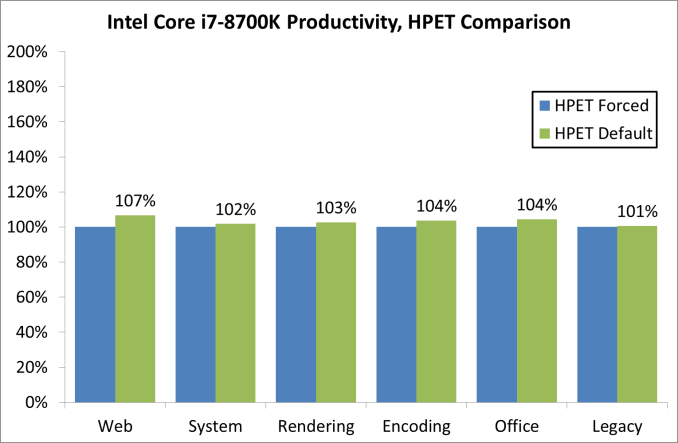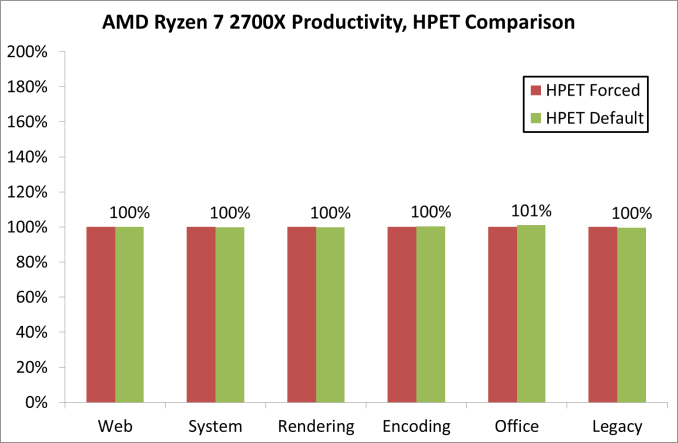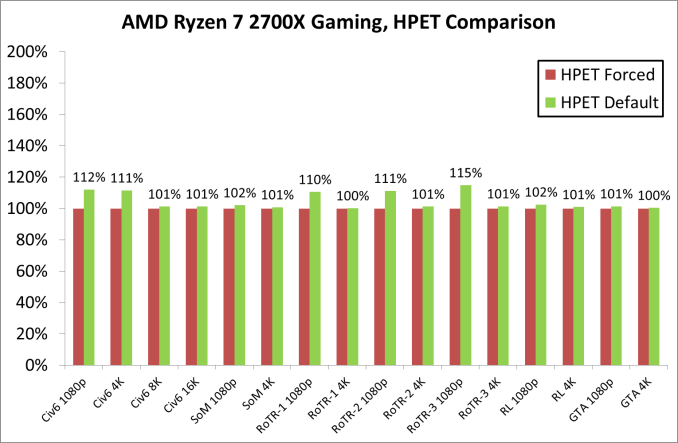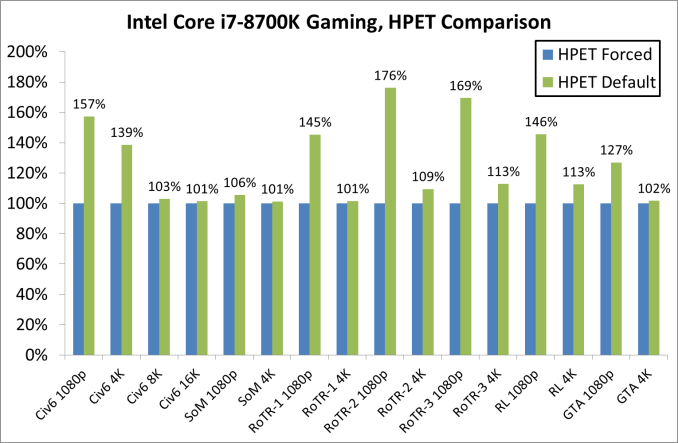A Timely Discovery: Examining Our AMD 2nd Gen Ryzen Results
by Ian Cutress & Ryan Smith on April 25, 2018 11:15 AM ESTForcing HPET On, Plus Spectre and Meltdown Patches
Based on my extreme overclocking roots back in the day, my automated benchmark scripts for the past year or so have forced HPET through the OS. Given that AMD’s guidance is now that it doesn’t matter for performance, and Intel hasn’t even mentioned the issue relating to a CPU review, having HPET enabled was the immediate way to ensure that every benchmark result was consistent, and would not be interfered with by clock drift on special motherboard manufacturer in-OS tweaks. This was a fundamental part of my overclocking roots – if I want to test a CPU, I want to make certainly sure that the motherboard is not causing any issues. It really gets up my nose when after a series of CPU testing, it turns out that the motherboard had an issue – keeping HPET on was designed to stop any timing issues should they arise.
From our results over that time, if HPET was having any effect, it was unnoticed: our results were broadly similar to others, and each of the products fell in line with where they were expected. Over the several review cycles we had, there were a couple of issues that cropped up that we couldn’t explain, such as our Skylake-X gaming numbers that were low, or the first batch of Ryzen gaming tests, where the data was thrown out for being obviously wrong however we never managed to narrow down the issue.
Enter our Ryzen 2000 series numbers in the review last week, and what had changed was the order of results. The way that forcing HPET was affecting results was seemingly adjusted when we bundle in the Spectre and Meltdown patches that also come with their own performance decrease on some systems. Pulling one set of results down further than expected started some alarm bells and needed closer examination.
HPET, by the way it is invoked, is programmed by a memory mapped IO window through the ACPI into the circuit found on the chipset. Accessing it is very much an IO command, and one of the types of commands that fall under the realm of those affected by the Spectre and Meltdown patches. This would imply that any software that required HPET access (or all timing software if HPET is forced) would have the performance reduced even further when these patches are applied, further compounding the issue.
It Affects AMD and Intel Differently: Productivity
So far we have done some quick initial re-testing on the two key processors in this debate, the Ryzen 7 2700X and Intel Core i7-8700K. These are the two most talked about processors at this time, due to the fact that they are closely matched in performance and price, with each one having benefits in certain areas over the other. For our new tests, we have enabled the Spectre/Meltdown patches on both systems – HPET is ‘on’ in the BIOS, but left as ‘default’ in the operating system.
For our productivity tests, on the Intel system, there was an overall +3.3% gain when un-forcing HPET in the OS:
The biggest gains here were in the web tests, a couple of the renderers, WinRAR (memory bound), and PCMark 10. Everything else was pretty much identical. Our compile tests gave us three very odd consecutive numbers, so we are looking at those results separately.
On the AMD system, the productivity tests difference was an overall +0.3% gain when un-forcing HPET in the OS:
This is a lower gain, with the biggest rise coming from PCMark10’s video conference test to the tune of +16%. The compile test results were identical, and a lot of tests were with 1-2%.
If Affects AMD and Intel Differently: Gaming
The bigger changes happen with the gaming results, which is the reason why we embarked on this audit to decipher our initial results. Games rely on timers to ensure data and pacing and tick rates are all sufficient for frames to be delivered in the correct manner – the balance here is between waiting on timers to make sure everything is correct, or merely processing the data and hoping it comes out in more or less the right order: having too fine a control might cause performance delays. In fact, this is what we observe.
With our GTX 1080 and AMD’s Ryzen 7 2700X, we saw minor gains across the board, however it was clear that 1080p was the main beneficiary over 4K. The 10%+ adjustments came in only Civilization 6 and Rise of the Tomb Raider.
Including the 99th percentile data, removing HPET gave an overall boost of around 4%, however the most gains were limited to specific titles at the smaller resolutions, which would be important for any user relying on fast frame rates at lower resolutions.
The Intel side of the equation is where it gets particularly messy. We rechecked these results several times, but the data was quite clear.
As with the AMD results, the biggest beneficiaries of disabling HPET were the 1080p tests. Civilization 6 and Rise of the Tomb Raider had substantial performance boosts (also in 4K testing), with Grand Theft Auto observing an additional +27%. By comparison, Shadow of Morder was ‘only’ +6%.
Given that the difference between the two sets of data is related to the timer, one could postulate that the more granular the timer, the more the effect it can have: on both of our systems, the QPC timer is set for 3.61 MHz as a baseline, but the HPET frequencies are quite different. The AMD system has a HPET timer at 14.32 MHz (~4x), while the Intel system has a HPET timer at 24.00 MHz (~6.6x). It is clear that the higher granularity of the Intel timer is causing substantially more pipeline delays – moving from a tick-to-tick delay of 277 nanoseconds to 70 nanoseconds to 41.7 nanoseconds is crossing the boundary from being slower than a CPU-to-DRAM access to almost encroaching on a CPU-to-L3 cache access, which could be one of the reasons for the results we are seeing, along with the nature of how the HPET timer works.
There is also another aspect to gaming that does not appear with standard CPU tests: depending on how the engine is programmed, some game developers like to keep track of a lot of the functions in flight in order to either adjust features on the fly, or for internal metrics. For anyone that has worked extensively on a debug mode and had to churn through the output, it is basically this. If a title had shipped with a number of those internal metrics still running in the background, this is exactly the sort of issue that having HPET enabled could stumble upon - if there is a timing mismatch (based on the way HPET works) and delays are introduced due to these mismatches, it could easily slow down the system and reduce the frame rate.














242 Comments
View All Comments
bbertram - Wednesday, April 25, 2018 - link
Well this is interesting! This could have serious implications.Googled HPET really quick and found this: https://www.reddit.com/r/Planetside/comments/416ns...
and then I found this link from that thread....a little ironic.
https://forums.anandtech.com/threads/do-you-have-h...
bbertram - Wednesday, April 25, 2018 - link
An interesting article that talks more about the issue. They look to even have a benchmark to show the impact. The video is also very interesting. The more I research this problem the more i see its been know for a very long time now.https://tinyurl.com/yd8qsh7w
bbertram - Wednesday, April 25, 2018 - link
ohhh...more nice info: https://tinyurl.com/yd39zw8c_mat - Wednesday, April 25, 2018 - link
Very thorough article. I like to point out a few things though, that may add some information to this.AMD and especially Intel have swept this problem under the rug since the launch of Skylake X. I noticed this problem while benching for a review and initially thought that my OS installation was the cause. After some testing I finally found the same root of evil as Ian did. At that time I made a video and called it the "Intel X299 HPET" bug (can't post a link, it was already mentioned in the comments here).
I tried to talk to PR and engineers at Intel for quite a while and they heard about my bug report but refused to comment. Time went by and Threadripper and Coffee Lake were born, both inheriting the same slow HPET QPC timer calls. I informed Intel repeatedly, still no comment.
During that time I wrote the following benchmark that sheds some light on the whole QPC and timer business on Windows. It shows your Windows timer configuration, gives recommendations for precision and performance, provides a way to bench your QPC timer in a synthetic and a game test and gives easy access to change TSC to HPET and vice versa.
As I am not able to post a link here, please search for "TimerBench", you will be able to download it.
I am also the author of GPUPI, one of those benchmarks for overclockers mentioned in the article that enforced HPET timers for secure timing a while back. Since discovering the HPET bug I have pulled back on this restriction. Since Skylake HPET is no longer necessary to avoid BCLK skewing, iTSC is just fine. AMD is still affected though, possibly Ryzen 2 as well (Threadripper and Ryzen 1 was).
bbertram - Wednesday, April 25, 2018 - link
Link to download: https://tinyurl.com/y7w6tg36Link to article: https://tinyurl.com/yd8qsh7w
Arbie - Thursday, April 26, 2018 - link
Wow! Google translator is amazing when going from German to English!mapesdhs - Sunday, May 6, 2018 - link
Might be because English has its roots in Germanic languages. :D Old English sounds a lot like common words in Dutch, and there's a region in Germany where the way German is spoken can sound to other Germans to be rather like English (according to a German guy I know). It's all those pesky Saxons, Angles, etc. :DTrackSmart - Wednesday, April 25, 2018 - link
Thank you _mat! Hopefully your comment gets attention here at Anandtech, and in turn, this article and your work get some attention from Intel. On the AMD side, it sounds like enabling HPET has only a small penalty in most cases, but those differences on the Intel side are very troubling. At the very least we should be forewarned!Dark_wizzie - Wednesday, April 25, 2018 - link
What software causes HPET to be forced on in Windows? I have multiple software installed but it still appears off.Dec666 - Wednesday, April 25, 2018 - link
Hi, AT.First of all, I wanted to thank you for an extreme effort you put in your reviews and analysis.
My thinking on the subject is that if you disable HPET in OS, this may make your numbers and review conclusion be irrelevant to the real world scenarios. As you have said, many programs (like video streaming, monitoring/overclocking, and potentially motherboard software (not to say about Ryzen Master)) require HPET to be enabled in OS and they will force it during the installation process and most likely won’t inform you about this. That means, that if you’ve installed all the software you going to use on fresh OS (and/or fresh PC), it is very possible that some of that software will have HPET forced and you won’t know about it.
To my mind, most of people, who read CPU reviews, are enthusiasts and/or those, who want to make a decision on CPU purchase by themselves. The majority of people will just buy PC based on others’ opinion or consultant’s advise. So those, for whom 10% difference in performance matters, and/or those, who bought expensive GPU like 1080/1080ti, will probably use monitoring software like HWinfo or Afterburner. That means, that HPET will be forced on their systems. That means, that they will have real world numbers close to what you’ve got in the original Ryzen 2000 review.
Another thing is that by disabling HPET in OS, while doing tests for a new review, you will hide the problem with it on Intel systems. People will not consider this as a potential performance hit or disadvantage of Intel platform in general.
Moreover, I suspect that in future more programs and, probably, next-gen games will require HPET (in order to better synchronize even more threads). Since most of people buy CPU for more than one year, they will have potentially worse experience with Intel CPUs in future, compared to AMD CPUs.
So it looks more logical to me to test CPUs with HPET forced (for all software), but have additional tests with HPET disabled for just games in order to have games tested with HPET both on and off. That will emphasize the problem. For me this is the same reason why it is important to test hardware with all Smeltdown patches and BIOS updates installed.
Thanks.